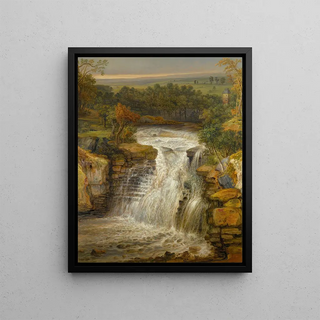Art print | The Clyde Falls after a flood - James Ward


View from behind

Frame (optional)
The artwork "Les chutes de la Clyde après une inondation" by James Ward is a piece that transports the viewer to the heart of a turbulent landscape, where the power of nature blends with human fragility. Painted in the early 19th century, this iconic work reflects the growing fascination of artists with natural scenery and extreme weather events. Ward, as a painter of nature, manages to capture not only the wild beauty of the falls but also the emotion emanating from this dramatic scene. Contemplating this piece, one feels a deep connection with the earth, a poignant reminder of the indomitable strength of the elements.
Style and uniqueness of the work
James Ward stands out for his realistic approach and his ability to render details of nature with an almost photographic precision. In "Les chutes de la Clyde après une inondation," he skillfully plays with light and shadow, creating a striking contrast that emphasizes the violence of the unleashed water. The colors, ranging from dark, stormy hues to vibrant shades of green and blue, evoke an atmosphere that is both unsettling and majestic. Ward succeeds in bringing the scene to life, making the viewer feel the humidity in the air and the deafening noise of the rapids. This artwork is not just a depiction of a place but a sensory experience that invites contemplation and reflection on the power of nature.
The artist and his influence
James Ward, born in 1769, was an English painter whose work marked his era through his commitment to landscape representation. Influenced by Romantic movements, he skillfully combined the beauty of nature with darker themes, such as destruction and chaos. His ability to capture fleeting moments of nature inspired many contemporary and later artists. Ward was also an active member of the Royal Academy, where he contributed to promoting British art. His unique vision of the landscape, tinged with an almost poetic sensitivity, paved the way for a new appreciation of nature in art, making him a key figure in 19th-century English landscape painting.

Matte finish

View from behind

Frame (optional)
The artwork "Les chutes de la Clyde après une inondation" by James Ward is a piece that transports the viewer to the heart of a turbulent landscape, where the power of nature blends with human fragility. Painted in the early 19th century, this iconic work reflects the growing fascination of artists with natural scenery and extreme weather events. Ward, as a painter of nature, manages to capture not only the wild beauty of the falls but also the emotion emanating from this dramatic scene. Contemplating this piece, one feels a deep connection with the earth, a poignant reminder of the indomitable strength of the elements.
Style and uniqueness of the work
James Ward stands out for his realistic approach and his ability to render details of nature with an almost photographic precision. In "Les chutes de la Clyde après une inondation," he skillfully plays with light and shadow, creating a striking contrast that emphasizes the violence of the unleashed water. The colors, ranging from dark, stormy hues to vibrant shades of green and blue, evoke an atmosphere that is both unsettling and majestic. Ward succeeds in bringing the scene to life, making the viewer feel the humidity in the air and the deafening noise of the rapids. This artwork is not just a depiction of a place but a sensory experience that invites contemplation and reflection on the power of nature.
The artist and his influence
James Ward, born in 1769, was an English painter whose work marked his era through his commitment to landscape representation. Influenced by Romantic movements, he skillfully combined the beauty of nature with darker themes, such as destruction and chaos. His ability to capture fleeting moments of nature inspired many contemporary and later artists. Ward was also an active member of the Royal Academy, where he contributed to promoting British art. His unique vision of the landscape, tinged with an almost poetic sensitivity, paved the way for a new appreciation of nature in art, making him a key figure in 19th-century English landscape painting.






